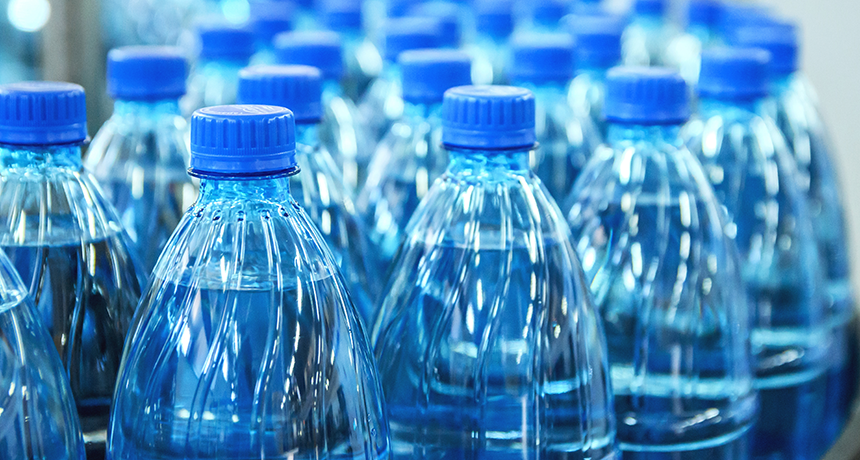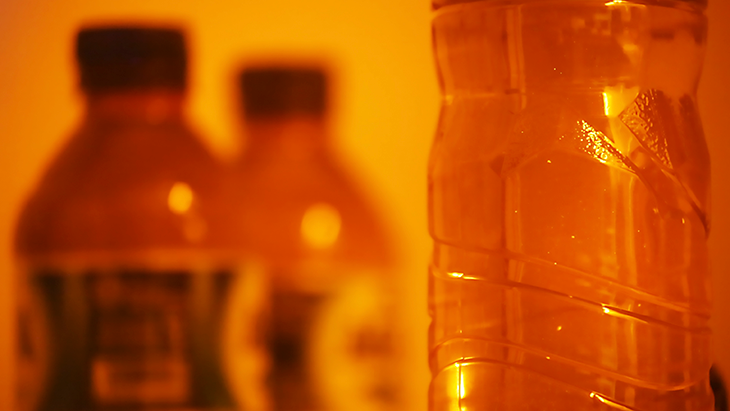Plastic taints most bottled water, study finds
Researchers don’t know whether drinking the microplastic bits might pose health risks

In recent tests, bottled water from nine countries contained tiny plastic bits. The microscopic pieces may come from a variety of sources including cosmetics, clothing and packaging materials.
yanik88/istockphoto
Tiny plastic bits contaminate bottled water sold around the world, a new study finds. For now, scientists can only guess at the source of the plastic. Whether ingesting it might pose any risk also remains unknown.
Researchers tested more than 250 bottles of water. They came from nine countries and were sold under 11 different brands. These included Nestle Pure Life, Aquafina, Dasani, Evian, San Pellegrino and Gerolsteiner. Plastic turned up in 93 out of every 100 of the bottles.
Each tainted liter (almost one quart) held an average of 10 particles wider than a human hair, along with 300 smaller particles. But some bottles contained more — thousands of the floating specks. These really tiny bits are often referred to as microplastic fibers.
Many of these particles “are small enough to be transported through our bodies and end up in our organs,” says Sherri Mason. She is a chemist at the State University of New York in Fredonia.
Mason and her team tested the water on behalf of Orb Media, a nonprofit journalism group based in the United States. Orb Media’s partners include the British Broadcasting Corporation (BBC) and the Canadian Broadcasting Corporation (CBC). Both of those outlets published stories about the research last month. To date, the results have not yet been peer reviewed or published in a scientific journal. The researchers did, however, post details of their study online March 14.
A continuing problem
Plastic pollution in the environment is nothing new. Tiny bits of plastic have turned up in rivers, lakes and oceans. Finding them has been easy. Figuring out their source has been harder.
Microplastics in water can come from larger pieces of plastic that break down in landfills and oceans. Sunlight and ocean waves also help break up pieces of plastic. Even clothes can shed microplastics. Fabrics such as fleece and nylon are made from plastic. When washed, they shed bits of plastic lint. It travels from the wash water down household drains and eventually into rivers, lakes and oceans.
Other microplastic beads go in some toothpastes and skin-care products. These beads help scrub away tooth plaque and dead skin cells. Then they, too, wash down the drain.
The most common type of plastic that Mason and her team found in bottled water was polypropylene (Pah-lee-PROH-puh-leen). This is the same type used in bottle caps. They also found bits of nylon and polyethylene terephthalate (Pah-lee-ETH-uh-leen Tair-eh-THAAL-ayt), also known as PET. PET is the main plastic used in water bottles.
So how do they get into bottled water? Once plastic bits go down the drain, it will wash into — and then out of — water treatment plants (because they were not designed to filter the plastics out). These facilities release their water into rivers and the ocean. Some of that water may move into groundwater, which some companies use for bottled water. Other companies may use city tap water. And earlier studies had found plastic bits could come out in tap water. The source of that plastic, too, might be contaminated lakes or rivers.
The new study is the first to find microplastics in bottled water, its authors say. In fact, Mason notes, her team found at least twice as many particles in bottled water as earlier tests had found in tap water.
Scientists aren’t sure what ingesting the tiny bits of plastic might do to our health. “But we know it probably isn’t good,” Mason says.
Plastics are made from many types of chemicals. There isn’t yet enough research to know how many of these might affect human health. After all, they were never designed to be eaten. Plastic also acts like a sponge, soaking up many types of chemicals. For example, pesticides and other toxic compounds have been found in plastics floating in the ocean. So plastic particles might ferry such pollutants into bottled water, too.
Dyes mark the plastic
Andrew Mayes is a chemist in England at the University of East Anglia, in Norwich. This is the largest study of bottled water he says he’s ever seen. “The main message from the study is that microplastics are all around us,” says Mayes. And, he adds, they “are getting into everything we eat, drink and probably breathe.”
Mayes helped to develop the method Mason and her team used to detect the microplastics. He has now reviewed how Mason’s group did its research and agrees with its findings.
Here’s what they did. They added a dye known as Nile Red to the bottled water. That dye sticks to plastic surfaces. (Some of the dye stuck to the insides of the bottles, too.) When viewed under blue light, the dye will glow. The researchers then poured the bottled water through a special type of paper. Water flows right through it, but larger molecules such as plastic get caught on the paper’s surface. The researchers put that paper under a microscope and shone a blue light on it. Then they counted the glowing plastic bits.
Story continues below image.

“It’s a bit like the glow-in-the-dark stars many kids have on their ceilings,” says Mason. “We counted the bright spots.”
The new study doesn’t say where the plastic bits in bottled water are coming from, Mayes notes. But it’s possible, he says, that they come from the bottle caps or the bottles themselves during processing and packing.
Mason worries that more and more plastic is turning up in the environment. Part of the problem, she says, is that we use a lot of disposable plastic. Plastic bags, bottles and straws are the major culprits.
“Say ‘no’ to straws, because they suck,” Mason recommends. “And don’t use plastic bags for wrapping sandwiches. There are reusable products you can use instead.”







